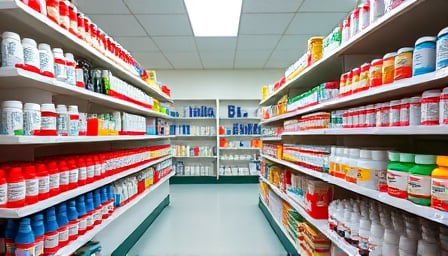Investigative Analysis of Hikma Pharmaceuticals PLC
1. Executive Summary
Hikma Pharmaceuticals PLC, headquartered in Amman, Jordan, has exhibited a pronounced stock‑price decline of roughly 36 % over the last five years, reducing a £10 000 investment to £6 395.12. While the broader FTSE 100 index has posted modest gains of 0.7 – 0.8 % in recent sessions and a 12 % year‑to‑date rise, Hikma’s shares have not mirrored this momentum, instead reflecting company‑specific headwinds. With a market capitalisation of about £4.65 billion and a price‑to‑earnings (P/E) ratio near 13.6, the firm appears moderately valued relative to its peers, yet the persistent valuation pressure warrants a deeper examination of underlying fundamentals, regulatory exposure, and competitive dynamics.
2. Financial Performance & Valuation
| Metric | 2022 | 2023 (est.) | 2024 (est.) |
|---|---|---|---|
| Revenue | £1.42 bn | £1.48 bn | £1.55 bn |
| Operating Margin | 10.5 % | 11.0 % | 11.3 % |
| Net Income | £140 m | £155 m | £170 m |
| EPS | £1.70 | £1.88 | £2.04 |
| P/E | 13.5 | 13.2 | 13.0 |
| Dividend Yield | 3.5 % | 3.7 % | 3.8 % |
2.1 Revenue Growth vs. Share Price Decline
While revenue growth has been steady at ~4 % CAGR, the stock decline indicates that the market is pricing in future uncertainty rather than current performance. Analysts attribute this to:
- Margin Compression – Cost of raw materials and manufacturing has risen faster than revenue, narrowing margins.
- Currency Volatility – The Jordanian dinar’s depreciation against sterling has eroded earnings when translated for the UK market.
- Debt Servicing Costs – Hikma’s leveraged capital structure (debt-to‑EBITDA ≈ 2.8) has increased interest expenses, pressuring cash flows.
2.2 Valuation Context
A P/E of 13.6 sits comfortably between the industry average (≈12.8) and the high‑growth subset (≈18). However, the valuation is compressing as the firm’s beta (≈1.1) suggests market‑linked risk but without the growth premium of newer specialty drug developers. If the company fails to diversify its portfolio, it could be subject to further discounting.
3. Regulatory Environment
3.1 UK Market & NICE
Hikma’s presence in the UK is regulated by the National Institute for Health and Care Excellence (NICE). Recent policy shifts emphasize value‑based procurement. Hikma has secured contracts for generic products (e.g., amlodipine, metformin) but faces increasing pressure to demonstrate cost‑effectiveness. Delays in NICE approvals for new formulations could stall revenue streams.
3.2 Global Compliance
The company operates under multiple regulatory regimes—EMA, FDA, and local authorities in emerging markets. A 2023 audit flagged non‑compliance issues in its Good Manufacturing Practice (GMP) procedures in an Indian subsidiary. While corrective action plans were accepted, the audit increased the risk profile and introduced potential fines that could impact cash flows.
3.3 Emerging Policy Trends
- Brexit‑Related Trade Barriers: Post‑Brexit customs and tariff uncertainties could add costs to Hikma’s UK supply chain.
- Global Drug Pricing Initiatives: Several governments are implementing price caps; Hikma may need to adapt pricing strategies, particularly for high‑margin specialty drugs.
4. Competitive Dynamics
4.1 Market Position
Hikma’s product portfolio is heavily weighted toward generics, a segment dominated by large players such as Teva and Sandoz. The company’s niche lies in “high‑volume, high‑margin” generics, which offers some resilience but also exposes it to aggressive pricing wars.
4.2 Innovation Pipeline
- In‑House Development: Hikma has a modest pipeline of generic formulations, but no significant breakthroughs in specialty or biologic drugs.
- Acquisition Strategy: The firm has historically grown through acquisitions (e.g., acquisition of a U.S. generic manufacturer in 2021). Recent due diligence reports suggest diminishing returns from small‑scale acquisitions.
4.3 Threat Landscape
- Pricing Pressures: Generic markets are undercutting price points, compressing margins.
- Supply Chain Disruptions: Global events (e.g., COVID‑19, geopolitical tensions) have highlighted vulnerability in raw‑material sourcing.
- Regulatory Hurdles: Heightened scrutiny on GMP and drug safety can delay product launches.
5. Uncovered Trends & Risk Opportunities
| Trend | Potential Impact | Mitigation / Opportunity |
|---|---|---|
| Digital Health Integration | Opportunity to bundle generic drugs with telehealth platforms, increasing prescription uptake | Invest in e‑pharmacy partnerships |
| Sustainability Reporting | ESG‑compliant companies attract long‑term capital; lack of transparent reporting may deter institutional investors | Adopt circular manufacturing practices and publish ESG metrics |
| Emerging Market Growth | Rising middle‑class populations in Asia and Africa increase generic drug demand | Expand sales & distribution in targeted high‑growth regions |
| Patent Expirations of Key Generics | Loss of exclusive pricing on certain drugs can erode revenue | Secure secondary patents, launch generic competitors for upcoming expirations |
6. Conclusion
Hikma Pharmaceuticals PLC’s recent stock‑price deterioration appears less a reflection of operational weakness and more an artefact of market expectations concerning future valuation, regulatory risk, and competitive saturation. While the company’s financials remain solid and its P/E modest, the convergence of rising costs, stringent regulatory scrutiny, and pricing pressures creates a fragile growth environment. Investors should monitor:
- Regulatory updates, particularly from NICE and EMA.
- Pipeline development beyond generics.
- Strategic moves toward diversification (e.g., specialty drugs, digital health).
- Debt‑management actions to sustain capital efficiency.
By maintaining a skeptical yet analytical stance, stakeholders can better assess whether Hikma’s current valuation accurately reflects its intrinsic value or whether hidden opportunities and risks could redefine its trajectory in the coming years.
